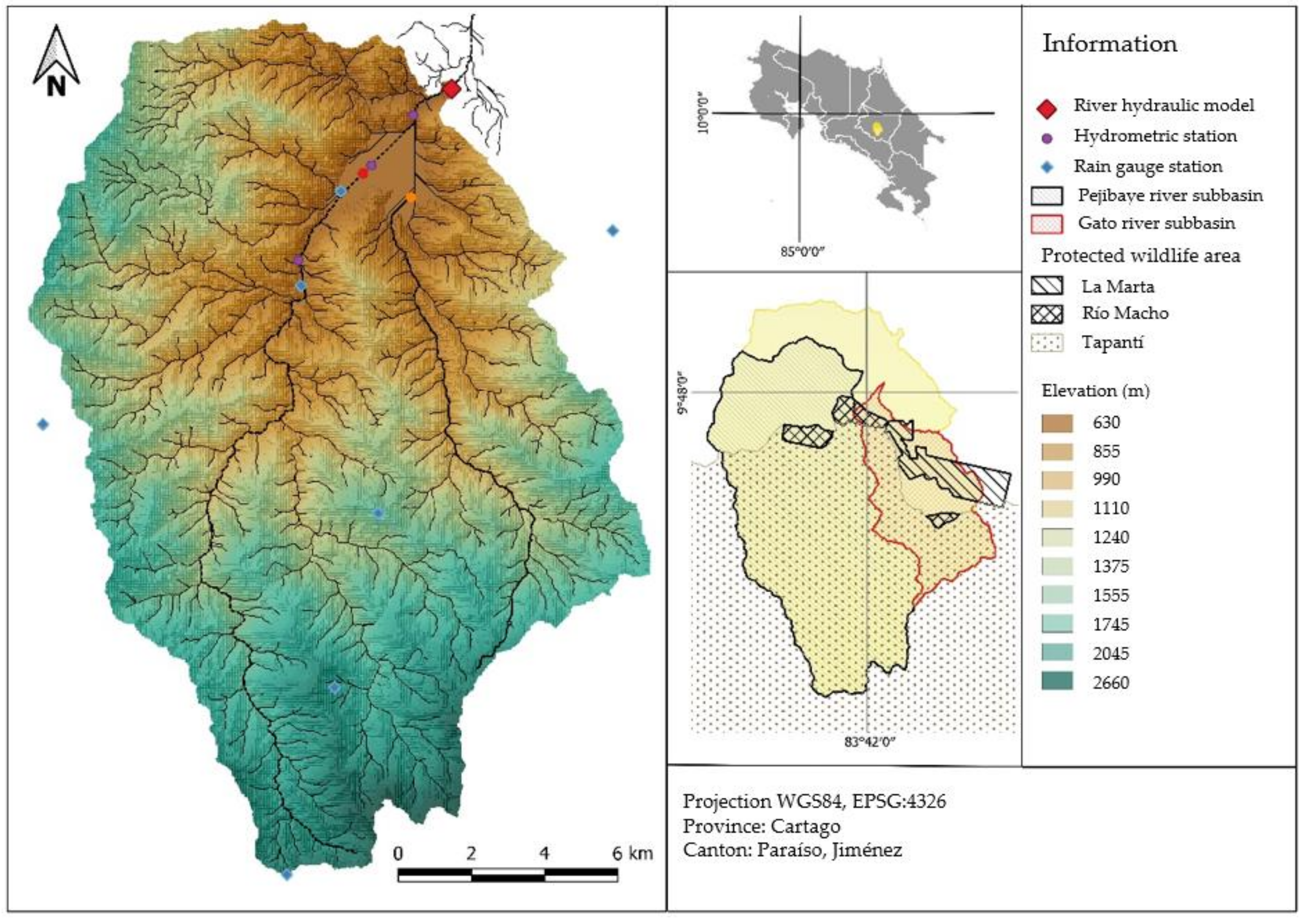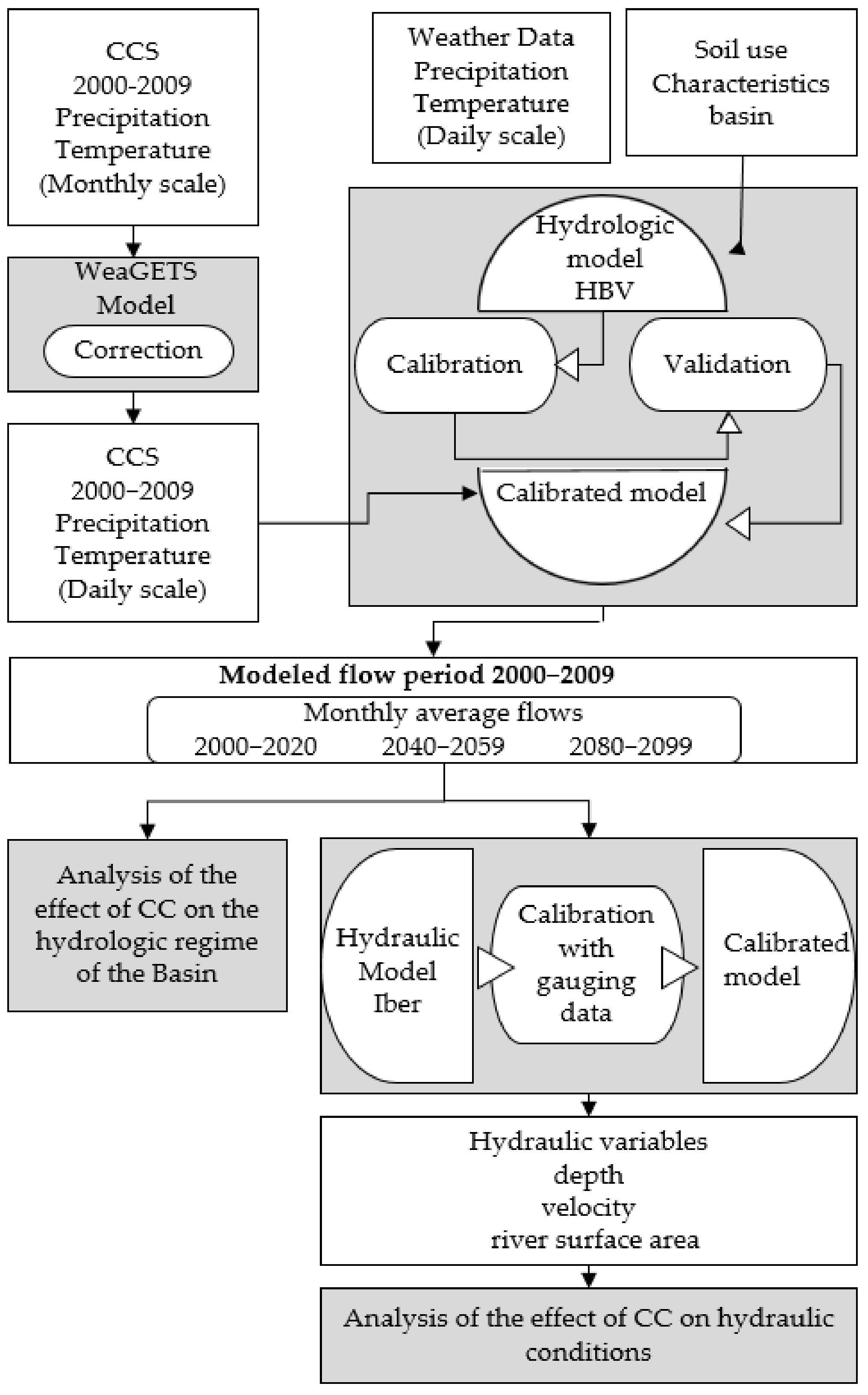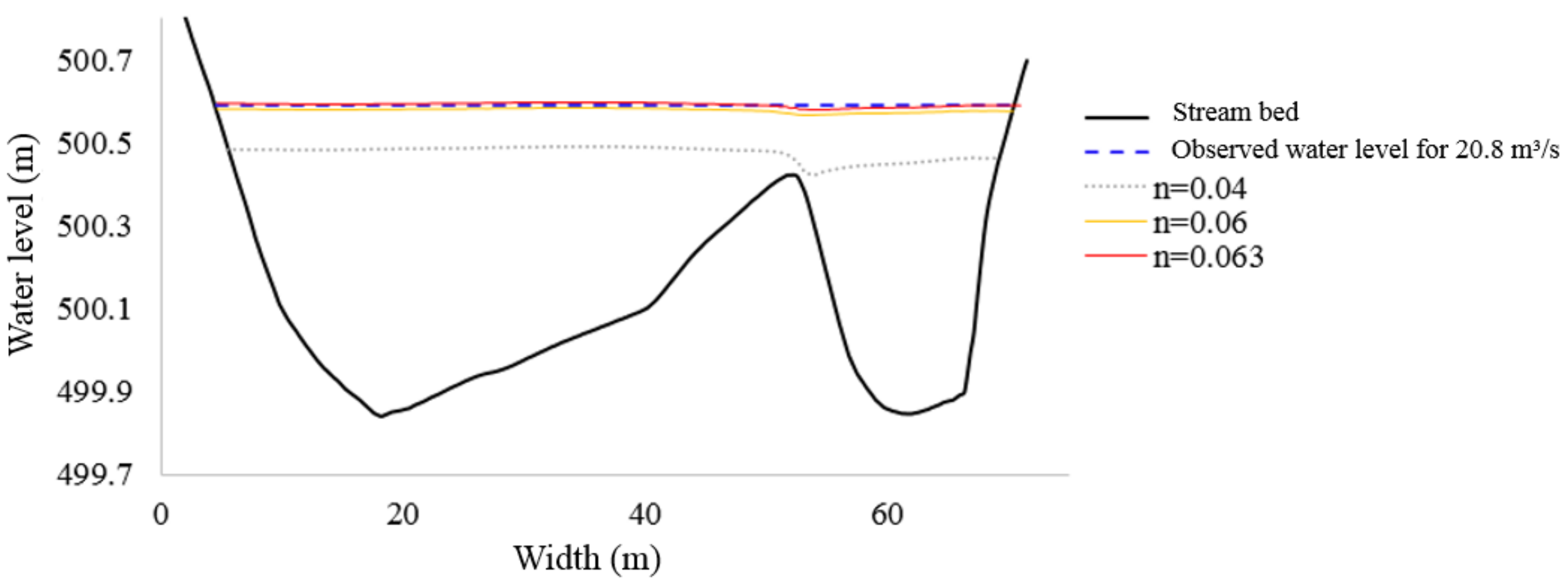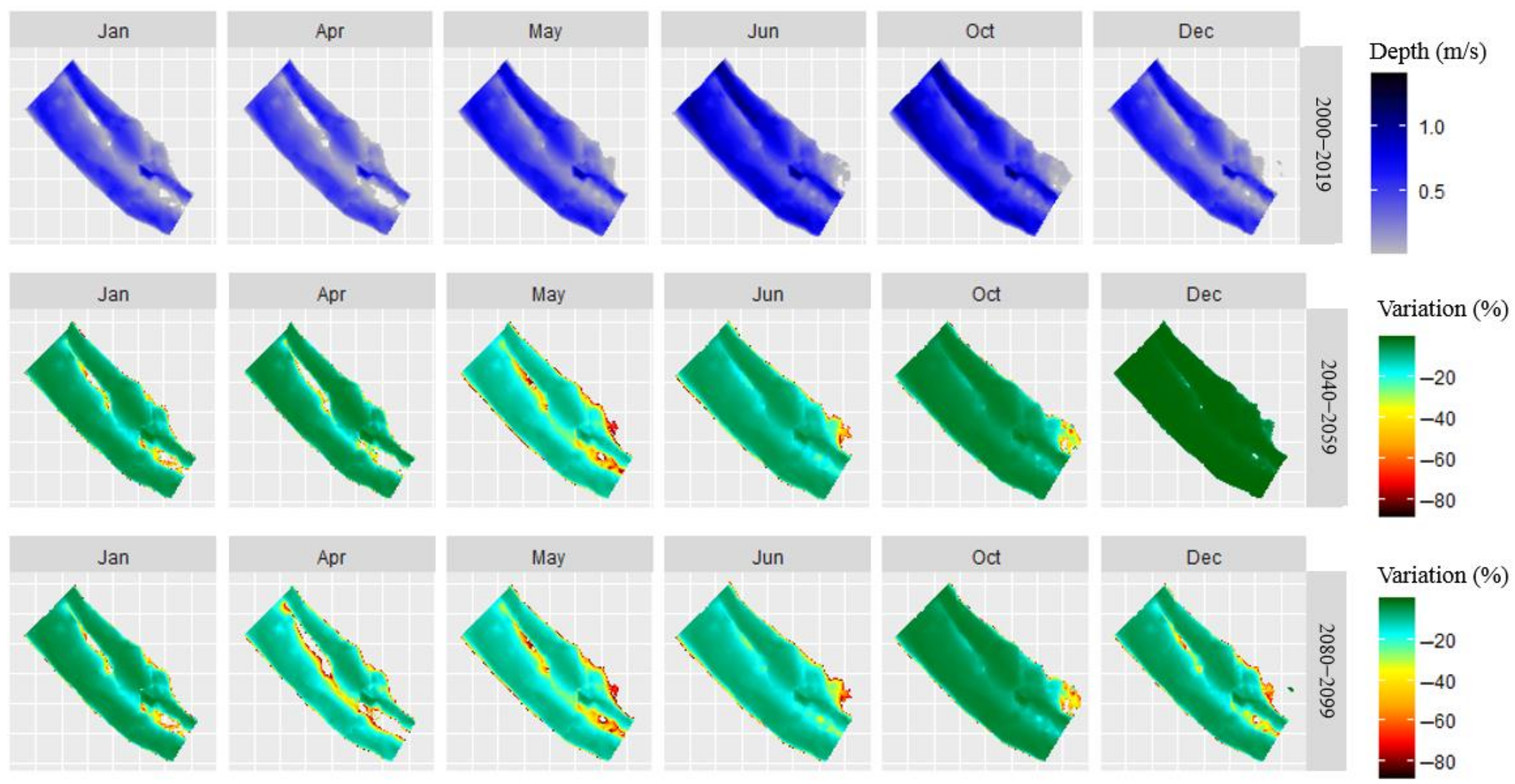The Effect of Climate Change on the Water Supply and Hydraulic Conditions in the Upper Pejibaye River Basin, Cartago, Costa Rica
Abstract
1. Introduction
2. Materials and Methods
2.1. Study Area
2.2. Hydrologic Model
2.3. Climate-Change Scenario
2.4. Hydraulic Model
3. Results
3.1. Hydrologic Modeling
3.2. Effect of Climate Change on the Water Supply
3.3. Hydraulic Modeling
3.4. CCS Effects on Hydraulic Parameters
4. Discussion
Author Contributions
Funding
Acknowledgments
Conflicts of Interest
References
- Skea, J.; Shukla, P.; Al Khourdajie, A.; McCollum, D. Intergovernmental Panel on Climate Change: Transparency and Integrated Assessment Modeling. WIREs Clim. Chang. 2021, 12, e727. [Google Scholar] [CrossRef]
- National Meteorological Institute [IMN]. Category Archive for Publications. Available online: http://cglobal.imn.ac.cr/index.php/publications/ (accessed on 20 March 2022).
- El Clima, Su Variabilidad y Cambio Climático En Costa Rica; Regional Water Resources Committee [CRRH]: San José, Costa Rica, 2008.
- Hidalgo, H.G.; Alfaro, E.J. Skill of CMIP5 Climate Models in Reproducing 20th Century Basic Climate Features in Central America. Int. J. Climatol. 2015, 35, 3397–3421. [Google Scholar] [CrossRef]
- Hidalgo, H.G.; Alfaro, E.J.; Quesada-Montano, B. Observed (1970–1999) Climate Variability in Central America Using a High-Resolution Meteorological Dataset with Implication to Climate Change Studies. Clim. Chang. 2017, 141, 13–28. [Google Scholar] [CrossRef]
- Ríos-Patrón, E. Manejo de Cuencas y Adaptación al Cambio Climático. Available online: https://www.researchgate.net/publication/281374585_MANEJO_DE_CUENCAS_Y_ADAPTACION_AL_CAMBIO_CLIMATICO (accessed on 20 March 2022).
- Watson-Hernández, F.; Chavarría-Pizarro, L.; Quesada-Alvarado, F.; Guzmán-Arias, I. Determinación Del Caudal Ambiental Mediante Una Metodología Hidrobiológica, Considerando Variables de Cambio Climático En El Río Pejibaye, Cartago, Costa Rica. Rev. Tecnol. En Marcha 2021, 34, 118–129. [Google Scholar] [CrossRef]
- Zuleta-Salmón, C.A. Análisis Del Comportamiento Del Recurso Hídrico Ante Cambios En El Uso Del Suelo y El Cambio Climático En La Cuenca Del Río Pejibaye, Costa Rica. Master’s Thesis, Centro Agronómico Tropical de Investigación y ENSEñanza [CATIE], Cartago, Costa Rica, 2013. [Google Scholar]
- Nonki, R.M.; Lenouo, A.; Tshimanga, R.M.; Donfack, F.C.; Tchawoua, C. Performance Assessment and Uncertainty Prediction of a Daily Time-Step HBV-Light Rainfall-Runoff Model for the Upper Benue River Basin, Northern Cameroon. J. Hydrol. Reg. Stud. 2021, 36, 100849. [Google Scholar] [CrossRef]
- Seibert, J. Estimation of Parameter Uncertainty in the HBV Model. Hydrol. Res. 1997, 28, 247–262. [Google Scholar] [CrossRef]
- Moriasi, D.N.; Arnold, J.G.; Van Liew, M.W.; Bingner, R.L.; Harmel, R.D.; Veith, T.L. Model Evaluation Guidelines for Systematic Quantification of Accuracy in Watershed Simulations. Trans. ASABE 2007, 50, 885–900. [Google Scholar] [CrossRef]
- Chen, J.; Brissette, F.P.; Leconte, R.; Caron, A. A Versatile Weather Generator for Daily Precipitation and Temperature. Trans. ASABE 2012, 55, 895–906. [Google Scholar] [CrossRef]
- Bladé, E.; Cea, L.; Corestein, G.; Escolano, E.; Puertas, J.; Vázquez-Cendón, E.; Dolz, J.; Coll, A. Iber: Herramienta de Simulación Numérica Del Flujo En Ríos. Rev. Int. Métodos Numéricos Para Cálculo Diseño Ing. 2014, 30, 1–10. [Google Scholar] [CrossRef]
- Ardıçlıoğlu, M.; Kuriqi, A. Calibration of Channel Roughness in Intermittent Rivers Using HEC-RAS Model: Case of Sarimsakli Creek, Turkey. SN Appl. Sci. 2019, 1, 1080. [Google Scholar] [CrossRef]
- Plesiński, K.; Michalik, P.; Radecki-Pawlik, A. Prognozowanie Zmian Korytotwórczych w Uregulowanym Korycie Rzeki Czarny Dunajec z Wykorzystaniem Modelu Jednowymiarowego. Przegląd Naukowy. Inżynieria I Kształtowanie Sr. 2017, 26, 346–360. [Google Scholar] [CrossRef][Green Version]
- Lindström, G.; Johansson, B.; Persson, M.; Gardelin, M.; Bergström, S. Development and Test of the Distributed HBV-96 Hydrological Model. J. Hydrol. 1997, 201, 272–288. [Google Scholar] [CrossRef]
- Beck, H.E.; van Dijk, A.I.J.M.; de Roo, A.; Miralles, D.G.; McVicar, T.R.; Schellekens, J.; Bruijnzeel, L.A. Global-Scale Regionalization of Hydrologic Model Parameters. Water Resour. Res. 2016, 52, 3599–3622. [Google Scholar] [CrossRef]
- Huang, S.; Eisner, S.; Magnusson, J.O.; Lussana, C.; Yang, X.; Beldring, S. Improvements of the Spatially Distributed Hydrological Modelling Using the HBV Model at 1 Km Resolution for Norway. J. Hydrol. 2019, 577, 123585. [Google Scholar] [CrossRef]
- Lyra, A.; Imbach, P.; Rodriguez, D.; Chou, S.C.; Georgiou, S.; Garofolo, L. Projections of Climate Change Impacts on Central America Tropical Rainforest. Clim. Chang. 2017, 141, 93–105. [Google Scholar] [CrossRef]
- Reyer, C.P.O.; Adams, S.; Albrecht, T.; Baarsch, F.; Boit, A.; Canales Trujillo, N.; Cartsburg, M.; Coumou, D.; Eden, A.; Fernandes, E.; et al. Climate Change Impacts in Latin America and the Caribbean and Their Implications for Development. Reg. Environ. Chang. 2017, 17, 1601–1621. [Google Scholar] [CrossRef]











| Parameter | Explanation | Minimum | Maximum | Units |
|---|---|---|---|---|
| FC | Maximum soil humidity (ground box storage) | 50 | 500 | mm |
| LP | Evaporation reduction range (SM/FC) | 0.3 | 1 | - |
| BETA | Shape coefficient | 1 | 6 | - |
| CET | Correction factor for potential evaporation | 0 | 0,3 | 1/°C |
| Response routine | ||||
| K1 | Recession coefficient (top box) | 0.01 | 0,4 | 1/d |
| K2 | Recession coefficient (bottom box) | 0.001 | 0,15 | 1/d |
| PERC | Maximum flow from upper to lower case | 0 | 3 | mm/d |
| MAXBAS | Routing, length of the ponderation function | 1 | 7 | d |
| Evaluation | NSE | PBIAS (%) |
|---|---|---|
| Very good | 0.75 < NSE < 1.00 | PBIAS < ±10 |
| Good | 0.65 < NSE < 0.75 | ±10 < PBIAS < ±15 |
| Satisfactory | 0.50 < NSE < 0.65 | ±15 < PBIAS < ±25 |
| Unsatisfactory | NSE < 0.50 | PBIAS > ±25 |
| Parameters | Description | Value | Source | |
|---|---|---|---|---|
| Basin | PERC | Percolation from upper to lower response box | 2.9123 | [16] |
| UZL | Threshold parameter for extra outflow from upper zone | 76.1697 | [17] | |
| K0 | Additional recession coefficient of upper groundwater store | 0.1968 | [17] | |
| K1 | Recession coefficient of upper groundwater store | 0.0451 | [17] | |
| K2 | Recession coefficient of lower groundwater store | 0.1022 | [17] | |
| MAXBAS | Transformation function parameter | 1.4355 | [16] | |
| Cet | Correction factor for potential evaporation | 0.1097 | ||
| PCALT | Elevation correction factor for precipitation | 0.2152 | [16] | |
| TCALT | Elevation correction factor for temperature | 0.5552 | [16] | |
| Forest | FC_1 | Maximum water storage in the unsaturated-zone store | 492.1819 | [17] |
| LP_1 | Soil moisture value above which actual evaporation reaches potential evaporation | 0.6469 | [17] | |
| BETA_1 | Shape coefficient of recharge function | 1.5149 | [17] | |
| Crops and pastures | FC_2 | Maximum water storage in the unsaturated-zone store | 69.1006 | [17] |
| LP_2 | Soil moisture value above which actual evaporation reaches potential evaporation | 0.9280 | [17] | |
| BETA_2 | Shape coefficient of recharge function | 4.3230 | [17] | |
| Construction and bare soil | FC_3 | Maximum water storage in the unsaturated-zone store | 67.1437 | [17] |
| LP_3 | Soil moisture value above which actual evaporation reaches potential evaporation | 0.9837 | [17] | |
| BETA_3 | Shape coefficient of recharge function | 4.6421 | [17] |
| Statistical | Calibration | Validation |
|---|---|---|
| NSE | 0.72 | 0.81 |
| PBIAS | −1.01 | 1.02 |
| R2 | 0.82 | 0.84 |
| Periods | Jan | Feb | Mar | Apr | May | Jun | Jul | Aug | Sep | Oct | Nov | Dec |
|---|---|---|---|---|---|---|---|---|---|---|---|---|
| Average monthly flow rates for the period 2000–2019 (m3/s) | ||||||||||||
| 2000–2019 | 17.35 | 15.47 | 13.92 | 13.40 | 28.61 | 44.73 | 38.27 | 41.80 | 45.49 | 45.06 | 32.86 | 25.57 |
| Reduction in average monthly flow compared to the period 2000–2019 (m3/s) | ||||||||||||
| 2040–2059 | −1.92 | −2.37 | −1.32 | −1.20 | −4.32 | −5.91 | −2.01 | −0.55 | −3.59 | −2.27 | −0.58 | −1.14 |
| 2080–2099 | −1.91 | −3.47 | −3.30 | −2.48 | −6.00 | −7.24 | −2.59 | −5.33 | −5.00 | −2.31 | −1.80 | −3.16 |
| Percentage reduction in average monthly flow compared to the period 2000–2019 (%) | ||||||||||||
| 2040–2059 | −11.1 | −15.3 | −9.5 | −9.0 | −15.1 | −13.2 | −5.3 | −1.3 | −7.9 | −5.0 | −1.8 | −4.5 |
| 2080–2099 | −11.0 | −22.4 | −23.7 | −18.5 | −21.0 | −16.2 | −6.8 | −12.7 | −11.0 | −5.1 | −5.5 | −12.4 |
| Period | Surface Width Area per Linear Meter of the Watercourse (m2/m) | |||||
|---|---|---|---|---|---|---|
| Jan | Apr | May | Jun | Oct | Dec | |
| 2000–2019 | 53.36 | 50.87 | 56.38 | 60.71 | 61.73 | 56.10 |
| Surface width reduction (m2/m) | ||||||
| 2040–2059 | −1.08 | −1.08 | −1.71 | −1.57 | −0.62 | −0.03 |
| 2080–2099 | −1.14 | −2.25 | −1.75 | −1.95 | −0.78 | −1.03 |
Publisher’s Note: MDPI stays neutral with regard to jurisdictional claims in published maps and institutional affiliations. |
© 2022 by the authors. Licensee MDPI, Basel, Switzerland. This article is an open access article distributed under the terms and conditions of the Creative Commons Attribution (CC BY) license (https://creativecommons.org/licenses/by/4.0/).
Share and Cite
Watson-Hernández, F.; Guzmán-Arias, I.; Chavarría-Pizarro, L.; Quesada-Alvarado, F. The Effect of Climate Change on the Water Supply and Hydraulic Conditions in the Upper Pejibaye River Basin, Cartago, Costa Rica. Hydrology 2022, 9, 76. https://doi.org/10.3390/hydrology9050076
Watson-Hernández F, Guzmán-Arias I, Chavarría-Pizarro L, Quesada-Alvarado F. The Effect of Climate Change on the Water Supply and Hydraulic Conditions in the Upper Pejibaye River Basin, Cartago, Costa Rica. Hydrology. 2022; 9(5):76. https://doi.org/10.3390/hydrology9050076
Chicago/Turabian StyleWatson-Hernández, Fernando, Isabel Guzmán-Arias, Laura Chavarría-Pizarro, and Francisco Quesada-Alvarado. 2022. "The Effect of Climate Change on the Water Supply and Hydraulic Conditions in the Upper Pejibaye River Basin, Cartago, Costa Rica" Hydrology 9, no. 5: 76. https://doi.org/10.3390/hydrology9050076
APA StyleWatson-Hernández, F., Guzmán-Arias, I., Chavarría-Pizarro, L., & Quesada-Alvarado, F. (2022). The Effect of Climate Change on the Water Supply and Hydraulic Conditions in the Upper Pejibaye River Basin, Cartago, Costa Rica. Hydrology, 9(5), 76. https://doi.org/10.3390/hydrology9050076








